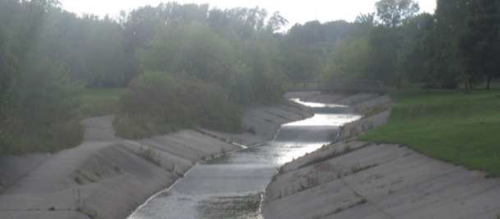If you would like to see more information on this case study, click here!
You can request this case study and a WCDE staff member will get back to you.
Storm water management is a major aspect of urban planning. With many impervious surfaces in a city, runoff easily travels to nearby creeks and lakes during a storm event. In the 1980s, one method of storm water management was to implement concrete riverbeds in an effort to move water out of residential areas quickly and to prevent erosion. Today, water resource engineers acknowledge that this creates a sediment-rich highway that negatively impacts water quality. In 2009, the City of Kitchener (the City) requested a Schedule B Class Environmental Assessment (EA) to address storm water management concerns for Victoria Park Lake, Kitchener. Stantec Consulting Ltd. was retained by the City to undertake the EA and they focused on the watershed and drainage channels that contribute to the lake. As a result of the EA, the City installed a forebay and armour stones as well as dredged the build-up of sediment in Victoria Park Lake. To protect this investment, the lake’s concrete-lined tributaries were identified as high priority. The City wanted to move towards naturalization of the tributaries, which meant converting them back as close as possible to their original state. This requires natural features like stream meanders and vegetation.
In September 2014, a capstone design team of Environmental Engineering students at the University of Waterloo began to design a naturalized channel for this application. Elizabeth Foran, Nicole Foris, Michael Nixon and Ronauq Sabharwal worked under the supervision of Dr. Bruce MacVicar.
 Concrete trapezoidal section of Victoria Park Lake tributaries in Kitchener, ON
Concrete trapezoidal section of Victoria Park Lake tributaries in Kitchener, ON
The goal of this case study is to expose students to a real-world, local problem on an open channel. This highlights tributary design from the 1980s and students will be able to analyze the impact of this design on sediment transport, channel flow, vegetation and water quality.
If you would like to see more information on this case study, click here!
You can request this case study and a WCDE staff member will get back to you.
Contact Waterloo Cases in Design Engineering
Steve Lambert
Tel: (519) 888-4728
Email: steve@uwaterloo.ca
The University of Waterloo acknowledges that much of our work takes place on the traditional territory of the Neutral, Anishinaabeg and Haudenosaunee peoples. Our main campus is situated on the Haldimand Tract, the land granted to the Six Nations that includes six miles on each side of the Grand River. Our active work toward reconciliation takes place across our campuses through research, learning, teaching, and community building, and is co-ordinated within the Office of Indigenous Relations.